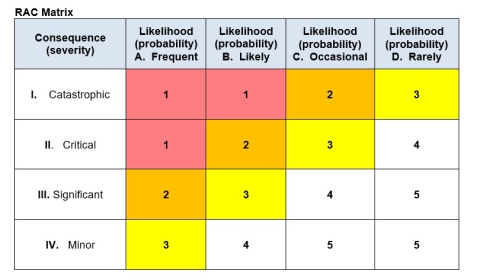The Department of the Interior (Department) describes its risk assessment system in 485 DM 6, Inspections and Abatement. The policy requires inspections, assignment of Risk Assessment Codes (RAC) to identified hazards, and abatement of the hazards within certain timeframes. The RACs are based on the hazard severity, probability of occurrence, and number of people exposed or potentially lost if there is an accident.
While all hazards should be resolved as soon as possible, the risk assessment system provides managers with safety risk ranking information to assist them in making informed decisions concerning hazard control. It also provides decisionmakers with a consistent and defensible approach to prioritizing safety hazard abatement efforts among the many competing resource demands and priorities.
Step 1 – Learn the terminology
Hazard – Anything that may cause harm, injury, or ill health.
Risk – A measure of both the likelihood (probability) and the consequence (severity) of all hazards related to an activity or condition.
Risk Assessment System (RAS) – A method provided by the Department to assist managers to prioritize safety and health deficiencies.
Risk Assessment Code (RAC) – A hazard number ranking system from 1 (the highest level of risk) to 5 (the lowest level of risk).
Risk Assessment Matrix – A tool used to assign RACs (see example below).
Step 2 – Using the RAC Matrix Tool, assign a code
Evaluate each deficiency based on both the likelihood (probability) of an outcome occurring and the consequence (severity) of a potential outcome. The junction on the matrix indicates the RAC number for that deficiency (hazard, condition, activity).
Likelihood Code – Code (A through D) indicating the probability or chance of an event occurring:
A. Frequent – Immediate danger to the health and safety of the public, staff, resources, or property; occurs frequently (at any given time) or continuously.
B. Likely – Probably will occur in time if not corrected, or probably will occur one or more times during the life of the system.
C. Occasional – Possible to occur in time if not corrected.
D. Rarely - Unlikely to occur; may assume exposure will not occur.
Consequence Code – Code (I through IV) indicating the severity of consequence resulting from exposure to a hazard:
I. Catastrophic – Imminent and immediate danger of death or permanent disability, chronic or
irreversible illness, major property or resource damage.
II. Critical – Permanent partial disability, temporary total disability greater than 3 months, significant
property or resource damage.
III. Significant – Hospitalized minor injury, reversible illness, period of disability of 3 months or less, loss or restricted workday accident, compensable injury or illness, minor property or resource damage.
IV. Minor – First aid or minor medical treatment. Presents minimal threat to human safety and health,
property, or resources, but is still in violation of a standard.
The junction on the matrix where likelihood meets consequence indicates the RAC number for that deficiency (hazard, condition, activity).
Step 3 – Apply a Risk Assessment Code according to RAC description
Typical Examples of Applying Risk Assessment Codes (RACs)
| Scenario | Violations, Conditions, and Potential Hazards | Likelihood (probability) | Consequence (severity) | RAC |
|---|---|---|---|---|
| Scenario One | Energized junction box is missing a cover. The box is within 8 feet of the floor and poses a potential electrocution hazard upon contact in a work area or frequently used walkway or corridor. | C | I | 2 |
| Scenario Two | Fire extinguisher not inspected or maintained. It is located in a sprinkler-protected area, and a potential fire poses a hazard with no protective measures. | B | III | 3 |
| Scenario Three | A confined space with a potential atmospheric hazard. The space is not labeled or marked as a permit-required space; no entry program has been developed. No known entries have been attempted, but the space is accessible, and it could pose an inhalation hazard. | C | I | 2 |
The assigned RACs shown in the table above are examples. Evaluating risk is a subjective process. Assigning RACs is often a judgment call for the person performing the inspection. Always consult your responsible Joint Administrative Operations (JAO) Safety Manager/Specialist for safety and occupational health guidance.

